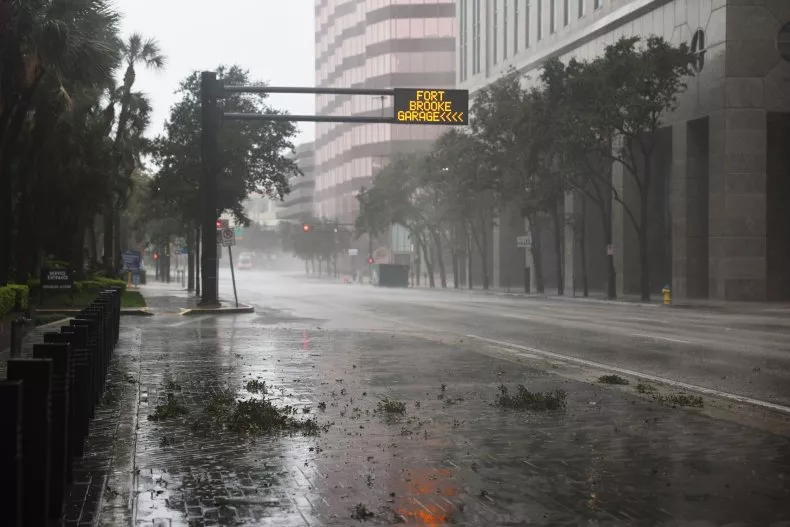Hurricane Milton could wreak havoc on America’s food supply

Sustainable Development Goals and the Potential Impact of Hurricane on Phosphate Facility
A severe hurricane hitting a major phosphate facility could lead to widespread consequences for the U.S. agricultural sector and food supply, an expert has warned.
Introduction
The Mosaic Company facility in Tampa, Florida, is one of the largest producers of phosphate-based fertilizers in the country and plays a critical role in ensuring a steady supply of key nutrients for crops such as corn, soybeans, and wheat.
Potential Impacts of Hurricane Milton
Josh Linville, director of fertilizer at financial services firm StoneX, has expressed concerns on Twitter about the potential impacts if Hurricane Milton were to hit the Mosaic facility. He raised the question of whether U.S. agencies would consider an emergency short-term repeal of counter-vailing phosphate duties against Morocco, Russia, and China to allow inventories to arrive.
Linville also highlighted his worries about infrastructure damage, particularly to the electric supply, and the well-being of workers who may need to take care of their friends and family before returning to work.
Importance of the Mosaic Facility
Located near Florida’s hurricane-hit Gulf Coast, the Mosaic facility produces a substantial portion of the phosphate used in fertilizers throughout the United States. The company holds a notable market share in the mineral and phosphate mining industry, accounting for an estimated 38.4 percent of total industry revenue.
Potential Consequences
In the event of a hurricane causing extensive damage, production at the Mosaic facility could halt for months, leading to severe disruptions in critical supply chains. The agricultural sector could experience higher fertilizer costs, crop shortages, and increased food prices for consumers.
Impact on Agricultural Output
More than a third of the phosphate used in U.S. agriculture comes from Florida’s phosphate operations, with Mosaic being the primary player. Any damage to the facility could reduce domestic production capacity, especially at a time when global fertilizer supply chains are already strained due to geopolitical factors and trade restrictions.
This disruption could result in farmers struggling to secure adequate fertilizer supplies, leading to delayed planting or the use of less effective alternatives. As a result, agricultural output could decrease, significantly impacting the prices of key commodities such as corn, soybeans, and wheat, which are crucial for the food supply and livestock feed.
Response from the U.S. Department of Agriculture (USDA)
The USDA has expressed concerns about rising input costs for farmers and the potential reverberating impacts on the agricultural sector. The department stands ready to help remedy disruptions and damage as quickly as possible. It also emphasizes the importance of investing in diverse and resilient supply chains, including through the Fertilizer Production Expansion Program.
Concerns from National Farmers Union
The National Farmers Union has highlighted the significant impact of hurricane damage to fertilizer plants on farmers. Any interruption in the supply of fertilizers can lead to higher prices and lower availability, especially considering the already consolidated fertilizer market. Restoring supply chains swiftly is crucial to avoid long-term challenges in food production and market stability.
Source: Newsweek
SDGs, Targets, and Indicators
| SDGs | Targets | Indicators |
|---|---|---|
| SDG 2: Zero Hunger | 2.4: By 2030, ensure sustainable food production systems and implement resilient agricultural practices that increase productivity and production, that help maintain ecosystems, that strengthen capacity for adaptation to climate change, extreme weather, drought, flooding and other disasters and that progressively improve land and soil quality. | – Crop shortages and increased food prices for consumers (implied) – Reduced agricultural output (implied) |
| SDG 12: Responsible Consumption and Production | 12.2: By 2030, achieve the sustainable management and efficient use of natural resources. | – Disruption in phosphate supplies (implied) |
| SDG 13: Climate Action | 13.1: Strengthen resilience and adaptive capacity to climate-related hazards and natural disasters in all countries. | – Potential impacts of Hurricane Milton on the Mosaic facility (implied) |
| SDG 15: Life on Land | 15.3: By 2030, combat desertification, restore degraded land and soil, including land affected by desertification, drought and floods, and strive to achieve a land degradation-neutral world. | – Progressive improvement of land and soil quality (implied) |
Source: newsweek.com








